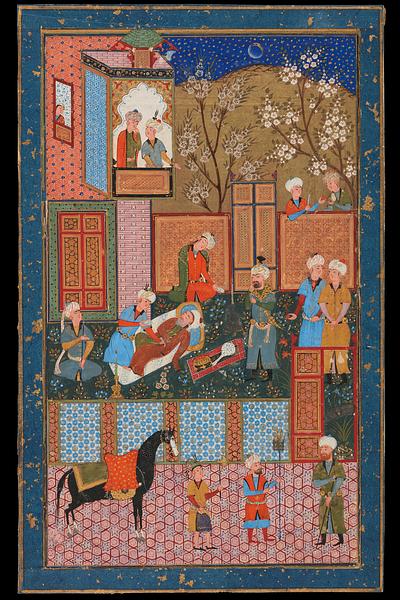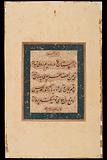This painting depicts a story of drunkenness, lust and resourcefulness. Despite having been warned against it, a judge has invited some young men to a drinking party and erotic congress, and the assembly has cavorted all night inside a walled garden. As morning drew near, the judge has fallen asleep on a rug, while one of his young drinking companions is propped up against the wall, sleeping with a wine cup still in his hand. Another young man lifts up the judge’s brown caftan with one hand while holding a wine cup in the other.
The sultan, who has caught wind of the debauchery, stands next to the judge, giving orders for him to be awakened while a group of curious courtiers look on. The prince, contemplating what punishment to mete out to the miscreant, holds a forefinger to his lips as a sign of thoughtfulness. Sadi’s story goes on to relate that the judge is initially sentenced to death, but defends himself with such wit and insight that the sultan pardons him. To those around him, the sultan justifies his leniency with a retort reminiscent of the words of Christ about the unfaithful woman: ‘All of you, who are fallible yourselves, should not accuse others of their faults’.
In the sixteenth century, Bukhara became a centre for the production of illustrated manuscripts when artists came there after fleeing Herat upon the fall of the Timurids. Part of the Timurid tradition was preserved, but at the same time the colours took on added intensity. The Bukhara style was also more realistic than contemporary Safavid painting. The best work of the Bukhara school appear to have been done in the mid-sixteenth century, with the leading artist of the time being Mahmud Muzahhib.
[1] The artist behind the present painting remains unknown, but the same composition and similarities in the depiction of several of the individual figures can be seen in a miniature from 1560–61, which is signed by Muzahhib.
[2] The paintings could conceivably have come from the same studio.


